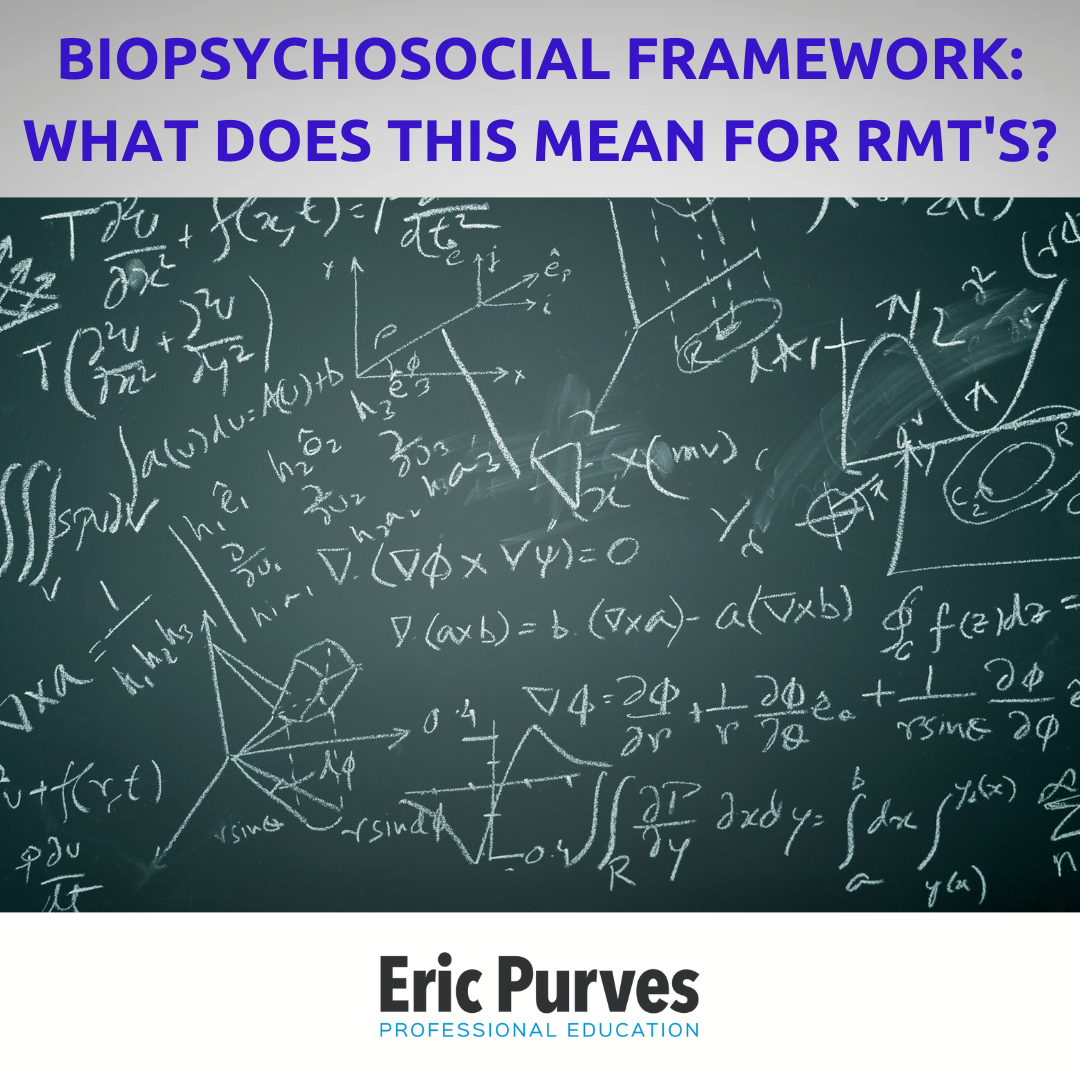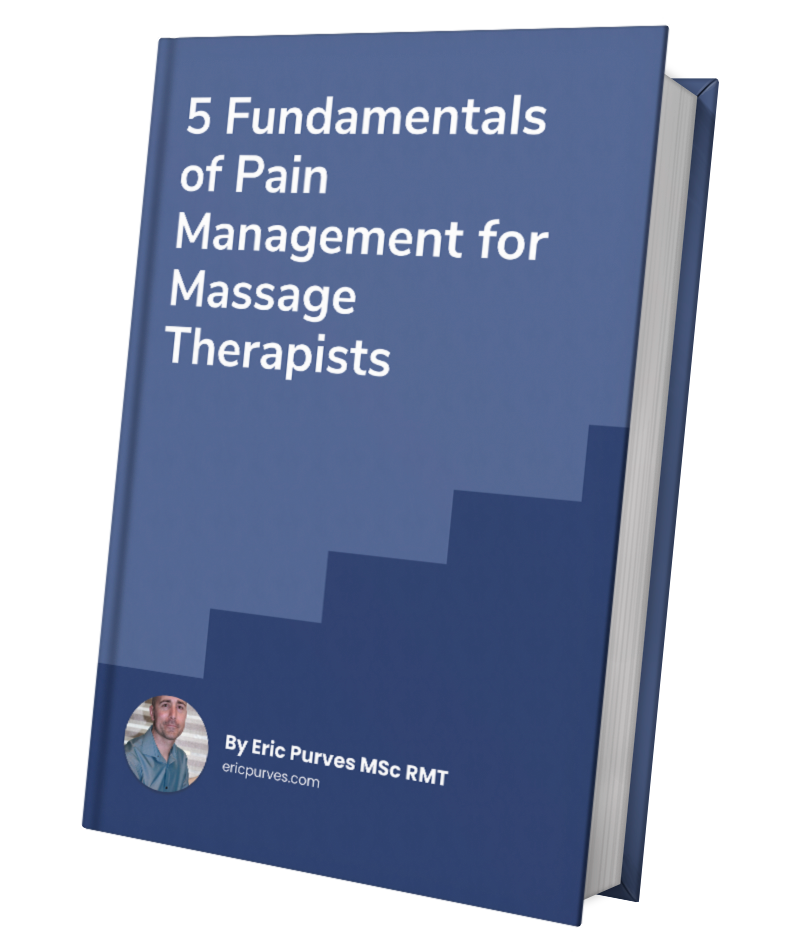This article was originally written for the magazine, Massage Therapy Today. I have edited it slightly for this blog post. It was used as part of the promotion for the RMTAO’s educational conference in Toronto on June 1st, 2019. The conference theme is the biopsychosocial model for RMTs. I was honoured to be presenting on two topics.
The concept and application of BPS can be widely interpreted and endlessly debated. This is my understanding and ideas for how it could be applied within the Canadian RMT profession.
History
The biopsychosocial (BPS) model was originally described in 1977 by George Engel, a professor of psychiatry at the University of Rochester. His paper, ‘The Need for a New Medical Model: A Challenge for Biomedicine’ was inspired by his attendance at a conference where dissenting opinions separated those who preferred the ‘neat and tidy’ world of biomedicine and those who felt current medical practice was ‘not relevant to behavioural and psychological problems.[1]’ Engel believed a new model was needed to address the totality of illness and its effects on behaviours. He highlighted the limitations of the biomedical model which does, ‘a great job at assessing and treating disease, but it is insufficient at understanding and treating the social, psychological and behavioural dimensions of illness.’
Relevance to RMT’s
The strength of the BPS framework is its ability to adapt and change within each clinical encounter. Maybe BPS is not even the best term to use? I would be open to change if something better came around. Maybe, rather than BPS we should use person centred? Taking a person centred approach would involve recognising the totality of the person’s unique experiences and would not involve clinicians trying to place clients/patients into 3 separate domains.
Practicing in a BPS framework, I prefer framework over model because a framework gives general principles to explore while a model is generally more specific and predictive in its interpretation, is not being a psychologist, sociologist or social worker. Understanding the influence of psychosocial factors on a person’s experience means our clinical reasoning and decision-making recognizes the multifactorial nature of the persons’ experience with pain/disability. These are constantly evolving influences and are always going to be involved in shaping behaviours. Thinking outside of the traditional pathoanatomical tissue focused narrative means the RMT should recognize more factors such as beliefs, feelings, worries and coping strategies. Social contributors can be vast! To name a few, this could be friends, family, culture, the work environment, or socio-economic factors. Knowing that all three domains interact is crucial to understand and appreciate the complexity of an individual’s personal experience with their health and well-being.
As RMT’s we are educated primarily in the pathoanatomical/biomedical model. Although there is mention of psychosocial and the complexity of pain related disability in some curricula, this is not the emphasis of our educational programs. Postural emphasis, tissue focused courses and recipe style approaches makes up the majority of RMT education across Canada, and I would wager the rest of the world too. Most RMT’s are familiar with the term BPS. However, thinking clinically within this framework and applying it to practice is a transition that requires a shift in one’s clinical reasoning and decision making.
The application of the BPS in practice is not straightforward. There is no linear pathway or treatment algorithm to follow. Clinical reasoning strategies become situated in various areas of grey rather than clearly identified interventions. It provides a useful structure to work from rather than a rule book to follow. Adopting a BPS framework fits perfectly with what RMT’s can do in practice and is within our scope and capabilities as regulated healthcare providers. Shifting our educational and regulatory systems towards a BPS framework requires that our profession acknowledge and appreciate the strengths of this model and the limitations of the biomedical approach. Is the BPS framework problematic? Yes, it has its limitations, but it includes the biomedical and recognizes that illness related behaviours and how people behave when they experience pain is not attributable to a single causative factor.
There are many possible reasons why this framework is not utilized more in our profession. BPS is not simple, it can be confusing trying to understand the multitude of factors that are inherent to each person’s unique experience. There is no correct way of doing things. The biomedical model is easier to comprehend. Most people understand the basics of biomechanics and they can rationalize pain or dysfunctions to something tangible like the sensation of a joint or soft tissue not functioning properly or feeling out of alignment. A key component is the ‘bio’ so let’s not forget its importance. What we need to be aware of is not all pain and disability can be solely attributed to mechanical explanations. Because the RMT profession lacks a culture of academia it makes it even more difficult to teach the complexities of philosophy, critical thinking and abstract ideas about pain. How do you educate new therapists about uncertainty and phenomenology, or learning skills to help understand the person’s lived experience? This requires educated instructors with advanced knowledge and skills outside of traditional massage therapy education.
A preponderance of debate can be seen on social media regarding the application of this model. Embracing the biopsychosocial mindset means the clinician looks at the totality of the evidence presented to them in each specific clinical encounter and evaluates it accordingly. People are more than their biology. We are complex biological organisms with thoughts, beliefs, feelings, and consciousness. At different times during the rehabilitation process the role of the bio, the psycho and the social will each be more relevant. Adopting a BPS approach means recognizing each domain and never dismissing anything, and being appreciative of how the components interact to form the patients’ unique experience.
Clinical Applications
The questions always remains, so what, who cares, what do I do with this information and how do I best help those who come to my clinic?
A biomedical approach often focuses on a singular component of dysfunction. Interventions are applied in an attempt to fix a pathoanatomical dysfunction in the tissue, joint, etc. Research going back to the 90’s suggests that tissue health becomes increasingly less important the longer pain persists, here. In recent years I have not seen anything that contradicts this statement. I am happy to admit to be wrong though 🙂 We have learned over the past decades that the longer someone hurts, the less likely the problem needs to be addressed using a singular approach. A better understanding of persistent pain and how to treat it is easily incorporated within the BPS framework. When people hurt for a long time it is suggested the person’s neuroimmune system is (dysfunctional/overactive, I am not sure of the correct term) and it results in increased activation of the nociceptive system, here, here, and here. Some of the potential variables that contribute to this sensitivity/activation are psychosocial. Fear, anxiety, catastrophic feelings, previous experiences and emotional health can potentially increase a person’s sensitivity to nociceptive stimuli. Being mindful of the biological components is important as soft tissues, joints and movement are still going to have relevance and should not be ignored. Treating the entire person should be the focus and supporting them to explore meaningful treatments and activities is the less wrong thing clinicians can do to increase the probabilities of positives therapeutic outcomes.
Trying to understand what variables are most important and how best to address them requires a clinical interview and assessment approach that focuses on understanding the entire person. Applying interview principles using active listening and patient validation allows the therapist to gain a better understanding of the patients’ experience and helps to build a strong therapeutic alliance which is important for successful rehabilitation outcomes. Open-ended questioning and being an active listener may provide more relevant information than a series of yes, no questions followed up by orthopaedic and special tests.
It is understandable that many of the acute pain complaints people experience have a biomechanical foundation. That could mean the person has adopted a posture, gait or movement pattern that is not beneficial. It is a common clinical reasoning error to think a biomechanical alteration is the cause of the patient’s problem, when the more likely explanation is it’s a response to them being in pain. Does this mean we ignore all the manual and movement interventions we have learned? Of course not! Let’s not ignore the bio, let’s put it in its place and reason when it is most relevant. Clinically, we need to accept the biology but also seek to understand the various psychosocial variables that can also contribute to the patient’s well-being. Meaningful patient education and self-care which includes a reconceptualization of pain combined with graded movements and activities are simple concepts that are easy to apply and may have profound success. One of the main misunderstandings with patient education is that it IS NOT intended to educate the person’s pain away. The purpose of education in my opinion is two-fold, (1) provide realistic knowledge so the person can give informed consent, and (2) influence behaviours that might be maladaptive to their well being. It is impossible to explain someone’s pain away, but this does not mean that in certain cases having a less wrong understanding of pain cannot be helpful for the person in their journey.
Future Direction
A curriculum that includes biopsychosocial approaches to healthcare must be developed and implemented into our education and supported by our professional associations and regulatory bodies. If RMT’s are going to follow an evidence-based framework supported by research and best practice guidelines, a BPS framework (or person centred) must be central to how our profession delivers care. Changing the culture of our profession will not be a simple accomplishment. It takes time, effort and ongoing education. It involves a paradigm shift in thinking and reasoning. Evolving into a BPS focused educational and clinical framework will require great force of will and continuous efforts, because it is an entire culture that will need to adapt. Change is occurring and the prevalence of pain science and BPS narratives are no longer fringe among allied healthcare providers. As health care professionals we have an ethical obligation to apply the most recent and relevant research into our practice. Appreciating the significance of BPS influences, learning and applying its principles for each clinical presentation is a better way forward for our profession to maintain its relevance and role in a constantly evolving healthcare environment.
My final thoughts
I strongly believe that RMTs, and all musculoskeletal healthcare professionals should focus their learning on knowledge acquisition and learn how to think and reason differently according to the latest science. I think it is important for RMTs to stop chasing different modalities and to stop looking for the new shiny tool to add in their toolbox. Choose a modality you like to use, do it well, and with confidence, and you will likely have a successful and satisfying career, Please don’t make up some unsupported story to go along with it because it is difficult to know how that message will be understood and internalized by your clients/patients.
[1]Engel, G. (1977). The need for a new medical model: A challenge to biomedicine. American Association for the Advancement of Science, 196 (4286), 129-126





2 Comments